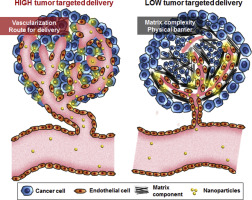Journal of Controlled Release ( IF 10.5 ) Pub Date : 2017-09-14 , DOI: 10.1016/j.jconrel.2017.09.015 Ji Young Yhee , Sangmin Jeon , Hong Yeol Yoon , Man Kyu Shim , Hyewon Ko , Jiwoong Min , Jin Hee Na , Hyeyoun Chang , Hyounkoo Han , Jong-Ho Kim , Minah Suh , Hyukjin Lee , Jae Hyung Park , Kwangmeyung Kim , Ick Chan Kwon

|
In cancer theranostics, the main strategy of nanoparticle-based targeted delivery system has been understood by enhanced permeability and retention (EPR) effect of macromolecules. Studies on diverse nanoparticles provide a better understanding of different EPR effects depending on their structure, physicochemical properties, and chemical modifications. Recently the tumor microenvironment has been considered as another important factor for determining tumor-targeted delivery of nanoparticles, but the correlation between EPR effects and tumor microenvironment has not yet been fully elucidated. Herein, ectopic subcutaneous tumor models presenting different tumor microenvironments were established by inoculation of SCC7, U87, HT29, PC3, and A549 cancer cell lines into athymic nude mice, respectively. In the five different types of tumor-bearing mice, tumor-targeted delivery of self-assembled glycol chitosan nanoparticles (CNPs) were comparatively evaluated to identify the correlation between the tumor microenvironments and targeted delivery of CNPs. As a result, neovascularization and extents of intratumoral extracellular matrix (ECM) were both important in determining the tumor targeted delivery of CNPs. The EPR effect was maximized in the tumors which include large extent of angiogenic blood vessels and low intratumoral ECM content. This comprehensive study provides substantial evidence that the EPR effects based tumor-targeted delivery of nanoparticles can be different depending on the tumor microenvironment in individual tumors. To overcome current limitations in clinical nanomedicine, the tumor microenvironment of the patients and EPR effects in clinical tumors should also be carefully studied.
中文翻译:

肿瘤微环境对乙二醇壳聚糖纳米粒子靶向递送的影响
在癌症治疗学中,通过增强大分子的渗透性和保留率(EPR)效应,已经了解了基于纳米粒子的靶向递送系统的主要策略。对各种纳米颗粒的研究根据它们的结构,理化性质和化学修饰提供了对不同EPR效果的更好理解。最近,肿瘤微环境已被认为是确定靶向肿瘤的纳米颗粒递送的另一个重要因素,但尚未充分阐明EPR效应与肿瘤微环境之间的相关性。本文中,通过将SCC7,U87,HT29,PC3和A549癌细胞系分别接种到无胸腺裸鼠中,建立了呈现不同肿瘤微环境的异位皮下肿瘤模型。在五种不同类型的荷瘤小鼠中,比较评估了自组装乙二醇壳聚糖纳米颗粒(CNP)的肿瘤靶向递送,以鉴定肿瘤微环境与CNP靶向递送之间的相关性。结果,新血管形成和肿瘤内细胞外基质(ECM)的程度均对确定靶向靶向CNP的肿瘤起着重要作用。在包括大量血管生成血管和低肿瘤内ECM含量的肿瘤中,EPR效应达到最大。这项全面的研究提供了大量证据,表明基于EPR效应的靶向纳米颗粒的肿瘤靶向递送可能会有所不同,具体取决于各个肿瘤中的肿瘤微环境。为了克服当前在临床纳米医学中的局限性,











































 京公网安备 11010802027423号
京公网安备 11010802027423号